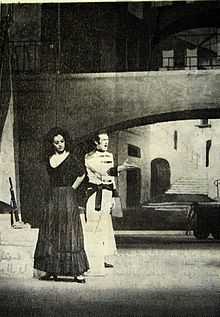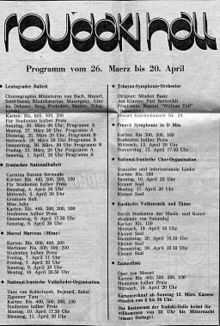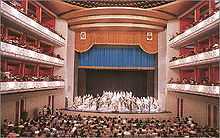Vahdat Hall
| Vahdat Hall | |
|---|---|
|
تالار وحدت Tālār-e Vahdat | |
|
| |
| Former names | Roudaki Hall |
| Alternative names | Roudaki Hall Opera |
| General information | |
| Type | Opera House |
| Architectural style | Modelled after the Vienna State Opera, Additions of the 1960’s: Italian style with elements and ornaments reiterating the forms of Persepolis, Additions of the 2000’s: Exterior entrance and gate: Modernism |
| Location | Ostad Shahriyar St. (former Dr. Arfa Avenue), Tehran, Iran |
| Construction started | 1957 |
| Completed | 1967 |
| Inaugurated | October 26, 1967 |
| Technical details | |
| Floor area | 9.200 sqm |
| Design and construction | |
| Architect | Eugene Aftandilian |
Vahdat Hall (Persian: تالار وحدت) formerly Roudaki Hall (Persian: تالار رودکی) or known internationally in past times as Roudaki Hall Opera [1] in Tehran, Iran, is a well-equipped, prestigious and modern venue and a legacy of a prosperous and developing period for Iranian music, dance and performing arts.
Named after a blind Persian poet of 9th and 10th century, Abu-Abdollāh Jafar-ibn Mohammad Roudaki, the opera house was among the 10 best-equipped and modern opera houses in the world at the time of its inauguration.[2] The Iranian national stage was a state institution of music, ballet and opera and the most famous performing scene for notable international artists and troupes in the Middle East.[3]
History
Construction

Roudaki Hall Opera was designed by the Iranian-American architect Eugene Aftandilian in the style of the Vienna State Opera and was constructed during a period of ten years starting in 1957.[4] It was equipped with the latest lighting and sound system technologies of the time with revolving and moving stages.The main stage consists of three different levels (podiums). The auditorium seats 1200 and has two tiers of boxes and balconies. The venue was fully supplied by Siemens Electrics. The main curtain in proscenium has a motif of a phoenix rising from the ashes (Persian Miniature style painting).
Just before the completion of Tehran’s new Opera house, Nejad Ahmadzadeh, Iranian National Ballet’s artistic director was sent by the Ministry of Culture and Arts to the United States to visit their opera houses and study administrative, organizational and technical constructions of American opera establishments that were deemed to be the most modern in the West and thereby more appropriate antitypes for modern Iran. At his return he was appointed as manager of the upcoming opera house and established the technical, administrative and artistic sections of the Roudaki Hall. The constructions of the opera house finally completed in 1967.
Inauguration
As part of the modernization program of the Shah for the country and its culture, Tehran’s Roudaki Hall Opera was constructed to function as the national stage for music, opera and ballet and was inaugurated by Mohammad Reza Shah Pahlavi and Empress Farah on October 26, 1967, on the occasion of their coronation. Two weeks of full house performances by international ensembles marked the coronation festivities. Numerous orchestras, opera singers and dance companies were invited to perform for the occasion.

Pre-revolutionary house productions and guest presentations

As the home for the Tehran Opera Company (National Opera of Iran), Iranian National Ballet Company and Tehran Symphonic Orchestra, numerous opera, dance and music performances were produced and presented at the Roudaki Hall Opera until the Islamic revolution of 1979. Moreover, other troupes, ensembles and artists such as the Mahalli Dancers of Iran, used the stage of the Roudaki Hall for their presentations either permanently, periodically or occasionally.
The opera and ballet productions of the Roudaki Hall Opera included:
Ballet
- Bijan and Manijeh (1975)
- La Bayadère (Season 1972-73)
- Myth of the Creation (1971)
- Nutcracker (1971)
- Bolero
- The Firebird (1967)
- Carmina Burana
- The Witch Boy
- The Fountain of Bakhchisarai (Season 73-74)
- Swan Lake (Season 1971-72)
- Petrouska
- Les Sylphides
- Giselle (Season 1970-71)
- La Fille Mal Gardée
- Romeo and Juliet (1968)
- Schéhérazade
- Coppélia (Season 1972-72)
- Miss Julie
- Cinderella (1969)
- Serenade
- Sleeping Beauty (1978)
Opera

- Pardis and Parisa
- La traviata
- Orfeo ed Euridice
- Madama Butterfly
- Turandot (1971)
- La bohème
- Carmen

Various national and international festivals were organized at the Roudaki Hall Opera during the pre-revolutionary era, among which:
- International Film Festival
- Ballet and Dance Festival
- Folk Dance Festival
- Annual Festival of Culture and Arts

World famous music, opera and dance artist and troupes visited Iran during a period of 11 years from the inauguration of the Roudaki Hall Opera in 1967 until the last stagings in the fall season of 1978 to stage their works at the Iranian national stage. These presentations of guest artists and ensembles included:
Guest ballet companies
- Kirov Ballet (Mariinsky Ballet)
- The Igor Moiseyev Ballet
- Le Grand Ballet Classique de France
- Antonio Gades Flamenco Ensemble
- Stuttgart Ballet
- Berliner Ballett
- Le Ballet de XXe Siécle (Ballet of the 20th Century)
Nederlands Dans Theater (1977)
Guest ballet artists (dancers / choreographers)
- Rudolf Nureyev
- Margot Fonteyn
- Robert de Warren
- Liane Daydé
- William Dollar
- John Cranko
- Marcia Haydée
- Richard Cragun
- Robert Urazgildiev
- Maurice Béjart
- Alvin Ailey
- Jiri Kylian
Guest opera singers
- Elizabeth Schwarzkopf
Guest music ensembles
- Moscow Symphony Orchestra
- Los Angeles Philharmonic Orchestra
- Berliner Philharmoniker
- Stuttgarter Kammerorchester
Guest musicians / conductors
Other presentations
- Marcel Marceau, the pantomime artist (1978)
Close down and reopening
At the time of the escalating political upheavals in Iran and the Islamic revolution in late 1978, the activities of the Roudaki Hall Opera were stopped and finally, the Opera House was closed down in order for the new regime to determine its fate. The hall, being a prestigious centre for presenting Western arts was often used by the government to propagate for the developing Iranian culture and arts. The Shah and the Empress were frequent visitors of the Opera House and its varied programs. In the eye of the new regime in Tehran, the venue was a symbol of Pahlavi government’s secular cultural agenda and also a landmark of the West’s cultural invasion. The opera ensemble and the Iranian National Ballet Company were dissolved and the artists were dismissed. The archive of the Roudaki Hall Opera including, dance costumes, videdteque, photo collections, and every thing else that was considered as corrupting and anti-Islamic was destroyed by the revolutionaries. It has been said that in the aftermath of the revolution, the Hall was at risk to be demolished like in the case of The Red Lion and the Sun Theatre Hall, another opera and music hall in Tabriz but some moderate among the new government opposed. The Hall was closed down during a period of time and re-opened sometimes during the ongoing Iranian Cultural Revolution (1980–1987). After re-opening of the Hall, the stucco relief of the Imperial Coat of Arms of Iran depicted on the balcony of the royal box in the auditorium was replaced by the emblem of the Islamic republic. Art works such as the large oil painting of the Pahlavi coronation along with any other elements reminding of the monarchy were removed. For 12 years the hall hosted the classical ballet and opera repertoire though the official archive of Vahdat Hall does not keep any records of that period.[5] All references to the country’s national ballet company have ever since been faded out. There is no mention of the Iranian National Ballet in any of Vahdat Hall’s publications or presentations.
After the Islamic Revolution

The construction of the Roudaki Hall Opera includes two venues named at the time of its opening as Roudaki Hall and the Small Hall. The construction as well as the two venues were renamed after the Islamic revolution of 1979. The main venue was renamed to Vahdat Hall (meaning unity in Arabic), and the small hall was called Roudaki Hall.[6] Since the Islamic Revolution no opera and ballet performances have taken place in Vahdat Hall.[7](retrieved date) The Hall does not host any permanent ensemble anymore alike the pre-revolutionary period and is used to stage a wide variety of events such as music concerts, theater plays, recitals, festivals, seminars, conferences, etc. In 2004, due to a private initiative, the former workshops of Vahdat Hall were turned into a puppet theatre: Ferdowsi Hall is the only stage for opera production in Iran nowadays. There are currently no plans to return Vahdat Hall to its originally intended use as a ballet and opera house.[8]
Post-revolutionary repertoire and guest presentations
Vahdat Hall has remained as Tehran’s most important and frequently used venues after the Islamic Revolution. Theatre plays of different genre such as the “Holy Defense Theatre”, “Religious Theatre”, including Harekat-e Mowzoon (Rhythmic Movements), music concerts of Persian traditional, pop and classical symphonic and orchestral music have been staged regularly. Among presentations on Vahdat Hall after the Islamic Revolution have been:
Concerts

- Vasl-e Yar Ensemble
- Gorgin Mousissian's Choir
- Tehran Symphony
- Nour Ensemble

Artists
- Loris Tjeknavorian
- Mohammad Reza Shajarian
- Hossein Alizadeh
- Ahmad Pejman
- Parvaz Homay
- Bagher Moazen
- Peyman Yazdanian
- Mohammad Esmaili
Theatre
- ?
- ?
- ?
Events
- International Fajr Film Festival
- International Fajr Theatre Festival
- Tehran Art Expo.[9]
Guest presentation
- Dundee Repertory Theatre
Technical Specification
Total capacity of the Hall: 750 People; Main Hall: 500 People, Balconies (three floors): 250 People
Stage Dimensions
- Proscenium opening: 12m
- Stage depth: 35m
- From hall’s end to the proscenium opening: 23.75m
- Stage height: 28m
- Deck height: 85 cm
- Proscenium opening height: 7m
- Forestage: 2.70m
Operational and artistic directors
General directors
- Hamed Rohani (1967-?)
- Abedin Zanganeh (?-1979)
- ? (1979-?) (after the revolution and before the re-organization of the Hall in 2003)
Following a legislation from the Islamic Parliament of Iran in 2003, the management of operation of the Hall has been reorganized. A new non-governmental public foundation has been established in order to be in charge of Tehran’s both cultural and artistic complexes of Vahdat Hall and Azadi Tower (Tower of Liberty, in Persian: برج آزادی - the former Shahyad Aryamehr Tower). The CEOs of Roudaki Foundation responsible for the operation of Vahdat Hall have been:
- Mehdi Massoudshahi (2003-2008)
- Ali-Asghar Amirnia (2008-2010)
- Hossein Parsaee (2010-2013)
- Hossein Seyfi (2013-?)
- Bahram Jamali (?-present)
Ballet directors
- Nejad Ahmadzadeh (1967-1976) The Iranian National Ballet was founded in 1958 and moved to Roudaki Hall Opera in 1967.
- Ali Pourfarrokh (1976-1979) held the position until disbanding of the Iranian National Ballet.
Opera directors
- Enayat Rezai (?-1979) (citation needed)
Music directors
- ?
- ?
- ?
Notes
- The history and existence of the Iranian ballet is forced to oblivion by the Islamic regime. There is no presentation about the Iranian National Ballet Company in the official website of the Roudaki Foundation nor in any of its publications. In 2002 Mahoor Institute for Culture and Arts based in Tehran, Iran, published the entire ballet music of Bijan and Manijeh composed by Hoseyn Dehlavi. There is no mention on the cover or in the CD booklet about the fact that “Bijan and Manijeh” was indeed a ballet music composed for the purpose of choreography.
References
- Notes
- ↑ Don Rubin, ed. (1998), The World Encyclopedia of Contemporary Theatre, London: Routledge, ISBN 0415059283, OCLC 32008932
- ↑ http://caoi.ir/index.php/en/projects/item/297-tehran-vahdat-hall-rudaki-hall
- ↑ Kiann, Nima (2015). The History of Ballet in Iran. Wiesbaden: Reichert Publishingi
- ↑ http://caoi.ir/index.php/en/projects/item/297-tehran-vahdat-hall-rudaki-hall
- ↑ http://www.danielkoetter.de/projekte/state-theatre-2-tehran
- ↑ beh bonyad-e farhangi-honari-ye Roudaki va majmoeh-haye tabe'eh (2011). Tehran: Public and International Relation office of the Roudaki Foundation
- ↑ http://www.danielkoetter.de/projekte/state-theatre-2-tehran
- ↑ http://www.danielkoetter.de/projekte/state-theatre-2-tehran
- ↑ "Tehran Art Expo to open on June 17". Tehran Times. June 16, 2012.
- Bibliography
- Fajr Theatre Festival
- Kiann, Nima. (2000). Persian Dance and Its Forgotten History
- Kiann, Nima (2015). The History of Ballet in Iran. Wiesbaden: Reichert Publishing
External links
| Wikimedia Commons has media related to Vahdat Hall. |
- Official Website of Roudaki Foundation
- Les Ballets Persans, the recreation of the Iranian National Ballet Company
- The chronology of the Iranian National Ballet Company and Les Ballets Persans
Coordinates: 35°41′59.12″N 51°24′40″E / 35.6997556°N 51.41111°E